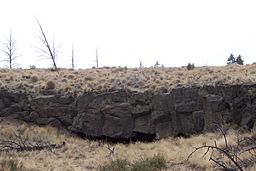Arnold Lava Tube System facts for kids
Quick facts for kids Arnold Lava Tube System |
|
|---|---|

Entrance to Backbone Cave
|
|
| Location | Deschutes County, Oregon, United States |
| Geology | Basalt of Lava Top Butte |
| Difficulty | Easy to moderate |
| Access | Varied |
| Cave survey | Mostly complete |
The Arnold Lava Tube System is a cool network of lava tubes in Deschutes County, Oregon, USA. It's located a few miles southeast of the city of Bend. This system starts in the Deschutes National Forest and stretches northeast.
These lava tubes were formed by ancient lava flows from a place called Lava Top Butte. This happened about 80,000 years ago! The lava flowed through these tubes, creating the tunnels we see today. The Arnold system is connected to other nearby lava features like the Badlands and the Horse Lava Tube System.
Contents
Discovering the Arnold Lava Tubes
The Arnold system got its name from Ronald Greeley, a scientist from NASA. He named it while studying lava tubes for the Oregon Department of Geology. He chose the name because of one of the first caves found in the system: Arnold Ice Cave.
People from the United States first found Arnold Ice Cave around 1889. They called it the Crook County Ice Caves. This cave was even used for mining ice! The ice was sold to the city of Bend. In the 1950s, Jim Anderson and Phil Coyner dug a trench into the ice. This allowed them to explore about half a mile of the cave. After the ice mining stopped, the cave filled up with ice again. This made the inner parts hard to reach.
Later, in the early 1970s, Ronald Greeley named another cave in the system, Deg Cave. He named it after Donald E. Gault, who worked at NASA Ames Research Center.
Even though Americans explored these caves, Native Americans knew about them much earlier. Scientists found evidence that people were using the caves as far back as 1370 AD. They learned this by carbon dating materials found in nearby Charcoal Cave no. 1.
Protecting the Caves
The lava tubes of the Arnold system have been used by local people for fun for a long time. Sadly, some people have damaged the caves through vandalism and other harmful actions.
The Central Oregon Conservation Task Force (COCTF) has documented the problems. For example, Rock climbing in the caves left climbing bolts and chalk marks. There were also reports of climbers ignoring Native American rock art and using chalk near it. Other problems included damaged signs, illegal campfires, and harm to plants. In 1997 alone, the damage was estimated at $71,000. The COCTF later removed climbing bolts to help restore the caves.
In the past, other harmful things happened. Bats were sometimes shot and killed by people with guns. The caves used to be home to many bats, including the special Townsend's big-eared bat. Because of these actions, bat populations in most of these caves have become very small or have disappeared.
The caves have also been damaged by people taking things. One collector removed rare lava stalagmites from Wind Cave. This same person also took ancient artifacts from other caves. These artifacts could have taught us a lot about the past.
Today, many people still enjoy the lava tubes and respect their beauty. However, vandalism still happens. Cave gates are sometimes broken by people trying to enter during times when bats are protected. Parties in the caves can also lead to trash, broken glass, and human waste being left behind.
Efforts to protect and restore the caves are ongoing. The United States Forest Service and the Bureau of Land Management work with the Oregon High Desert Grotto. Their goal is to keep the caves natural for bats and safe for people to visit. The Oregon High Desert Grotto is part of the National Speleological Society. They share the goal of protecting these special places. These caves are important for their geology, animals, history, and environment.
Bat Closures
To protect the bats, many caves in the Arnold system are closed during certain times of the year. This is especially important when bats are hibernating. The caves are closed for hibernation from November 1 to April 15. Gates have been put on many caves, like Bat Cave no. 1, to help restore bat habitats.
Some caves also have bat maternity colonies. This means mother bats raise their babies there. It's not fully known how many bats still use these colonies. Caves with maternity colonies are closed from April 16 to September 30. In the past, maternity colonies were found in Wind Cave, Bat Cave, Deg Cave, and Charlie-the-Cave.
Caves in the System
There are 20 known caves in the Arnold system. Only 8 of these caves are longer than two or three hundred feet.
Lava Tube Caves
Most of the main caves in the Arnold system are lava tube caves. Wind Cave is the longest and hardest to explore. It is 3,839 feet long!
Some of the caves include:
- Hidden Forest
- HFBD
- Charcoal Cave no. 1
- Neighboring Cave
- Arnold Ice
- Boulder
- Baker's Bin
- Osseo
- Charlie-the-Cave
- Unnamed
- Backbone
- Deg
- Bat Cave no. 1
- Upwind
- Wind
- Hyphenated
- Pictograph
- Charcoal Cave no. 2
- Stookey Ranch
Other Caves
A few other types of caves are found in the system. Most are small "talus caves" along collapsed parts of the lava tubes. Woolhiser Cave is another type of cave called a surface tube. It is a bit separate from the main lava tubes.
See Also
Images for kids


